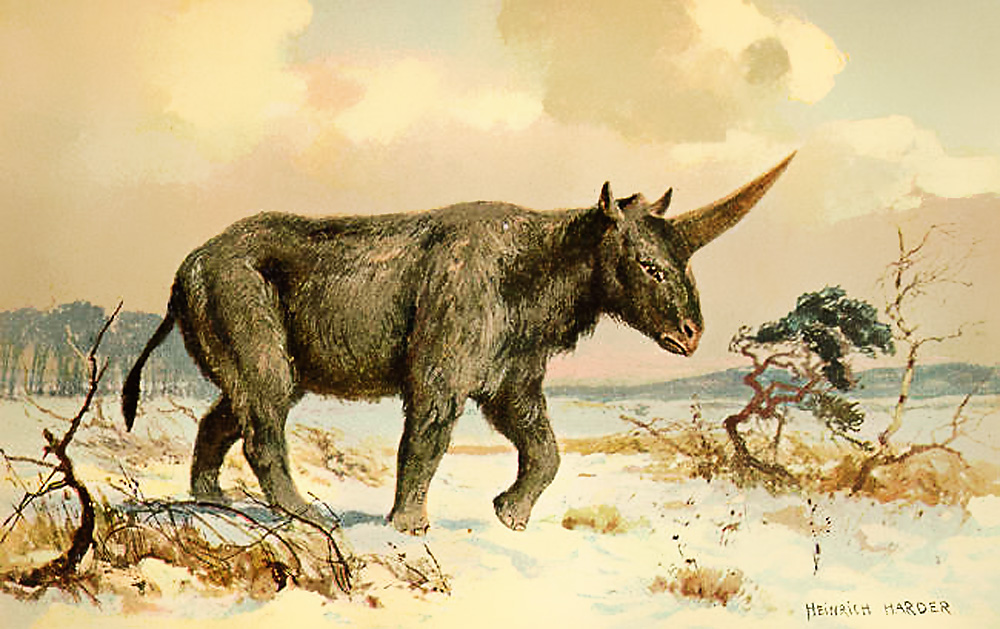The Siberian unicorn: some unknown facts

Restoration by Heinrich Harder from ca. 1920.
Wikipedia.orgThere has been considerable discussion in the global media recently about the phenomenon of the “Siberian unicorn.”' These creatures inhabited the Earth not 350,000 years ago as scientists earlier thought, but just 29,000 years ago. The mysterious folk tale character could easily have lived among Homo sapiens. Russian scientists from Tomsk State University recently discovered this fact with the help of radiocarbon dating.
The "unicorns" in question looked more like woolly rhinoceroses than thoroughbred horses.

First published restoration (1878) of E. sibiricum, by Rashevsky, under supervision of A.F. Brant. Source: Wikipedia.org
What other features about these ancient creatures could be a surprise? Here are five interesting details.
They had a peculiar diet. Despite the unicorn's huge size (an adult was around five or six metres long, and weighed more than five tons), its diet consisted mainly of tubers and plant bulbs. The creature could burrow into the ground and pull out edible roots. It had no incisors and canines, so it dug with hard horny lips. Scientists have speculated about how this species survived longer than cave lions or mammoths. Perhaps the diet had a role.
Siberia was warm. Remains of the animal were found in the south part of the West Siberian Plain, which is odd because they were regarded as warmth-loving animals. Previously, it was thought that they did not inhabit this area at all because it was too cold This find would indicate that the climate in the Urals and south Siberia was not as cold as once thought.
Pre-historic humans probably saw them. The animals depicted in cave paintings were not just a figment of our ancestors' imaginations, and it is possible that human hunters were responsible for their extinction, because ancient unicorns persisted through four or five ice ages. The reason for their disappearance remains a mystery, but it is unlikely that a glacial advance led to their extinction. Earlier, scientists hypothesized that unicorns were gradually superceded by mammoths.
The mysterious creature's horn, like the rest of its appearance, has nothing to do with the fairy tale character. The Siberian unicorn had a small domed bony elevation on its forehead, about 35 centimetres long and about 15 centimetres high. This was very strong and served as the base for a powerful horn.

Paleolithic art from Rouffignac Cave, France, judged on the basis of the single horn to depict Elasmotherium by Schaurte in 1964 and again independently by N. Spassov in 2001. Source: Wikipedia.org
There was an olfactory organ inside the "dome," so the creature had a keen sense of smell. Unlike the one-horned Indian rhinoceros, this creature's horn was on the forehead, not on the nose. Scientists estimate the length of the horn differently. According to some, it could be up to one or two metres.
Perhaps the animal had another horn. Since the 19th century, scientists have tried to recreate the Siberian unicorn's appearance.
For instance, zoology professor Alexander Brandt paid attention to the small roughness on the front end of the creature's nasal bones, suggesting the presence of a second horn.
It was a low horn plate located at the tip of the animal's muzzle.
However, none of these ancient creatures' horns have been found. After all, horns are formed from keratin, like hair and nails, and are almost never preserved. Paleontologists have speculated on the presence of horns only from the structure of the animal's skull.
All rights reserved by Rossiyskaya Gazeta.
Subscribe
to our newsletter!
Get the week's best stories straight to your inbox
